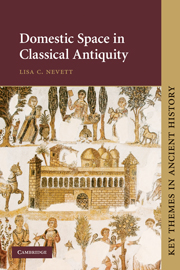Book contents
- Frontmatter
- Contents
- List of figures
- List of plates
- Preface and acknowledgements
- Map showing the locations of the sites and regions discussed in Chapters 3–6
- Introduction
- 1 Domestic space and social organisation
- 2 House-form and social complexity: the transformation of Early Iron Age Greece
- 3 A space for ‘hurling the furniture’? Architecture and the development of Greek domestic symposia
- 4 Housing and cultural identity: Delos, between Greece and Rome
- 5 Seeking the domus behind the dominus in Roman Pompeii: artefact distributions as evidence for the various social groups
- 6 Housing as symbol: elite self-presentation in North Africa under Roman rule
- Epilogue: domestic space and social organisation in Classical Antiquity
- Glossary
- Period names and dates referred to in this book
- Bibliographic essay
- Bibliography
- Index
4 - Housing and cultural identity: Delos, between Greece and Rome
Published online by Cambridge University Press: 05 August 2012
- Frontmatter
- Contents
- List of figures
- List of plates
- Preface and acknowledgements
- Map showing the locations of the sites and regions discussed in Chapters 3–6
- Introduction
- 1 Domestic space and social organisation
- 2 House-form and social complexity: the transformation of Early Iron Age Greece
- 3 A space for ‘hurling the furniture’? Architecture and the development of Greek domestic symposia
- 4 Housing and cultural identity: Delos, between Greece and Rome
- 5 Seeking the domus behind the dominus in Roman Pompeii: artefact distributions as evidence for the various social groups
- 6 Housing as symbol: elite self-presentation in North Africa under Roman rule
- Epilogue: domestic space and social organisation in Classical Antiquity
- Glossary
- Period names and dates referred to in this book
- Bibliographic essay
- Bibliography
- Index
Summary
Cleopatra, daughter of Adrastus of Myrrhinous, set up this image of her husband Dioscorides, son of Theodorus of Myrrhinous, who dedicated the two Delphic tripods of silver by each doorpost in the temple of Apollo, in the archonship of Timarchus at Athens.
Inscriptions de Délos 1987, inscribed on a statue-base in House iii.1, Theatre Quarter, Delos, 138/137 bceAll societies have culturally acceptable uses of domestic space.
Pader 1997, 72INTRODUCTION
In or about the year 138/137 bce, on the island of Delos, the sculpted portraits of a woman and a man were set up inside a house in an old residential neighbourhood of the main town (Plate 4.1). The figures are made of white marble and are depicted at life-size. Now missing their heads, each one poses in a manner comparable with other images of this period. He has his right arm crooked under the folds of a himation or robe – a stance used in Greek civic and funerary sculpture since the fourth century bce. She is pulling tight a thin shawl to reveal the folds of a thicker dress beneath, in a manner popular in sculpted figures of women from the third and second centuries bce. An inscription on the statue-base, written in Greek, identifies the couple and is quoted above. It refers to a gift made to the famous temple of the god Apollo on Delos, by Dioscorides, son of Theodorus, who came from the community of Myrrhinous (modern Merenda) in the territory of Athens.
- Type
- Chapter
- Information
- Domestic Space in Classical Antiquity , pp. 63 - 88Publisher: Cambridge University PressPrint publication year: 2010



